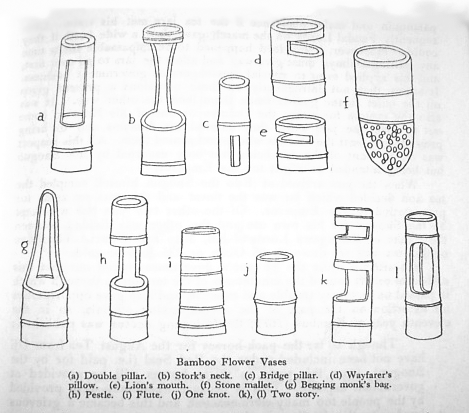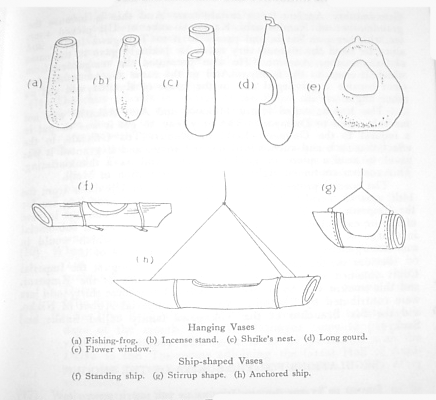TEA FOR THE ENPEROR AND THE TOKUGAWA SHOGUNS
徳川将軍達の茶
In the ninth year of Kwan-ei (1633) the third Tokugawa Shogun Iemitsu appointed eleven Cha-shi or Tea officers ; four from the house of Kambayashi of Uji, this family already having been made chief of the Tea-growers, and one each from the houses of Nagai, Sakata, Ozaki, Nagara, Hoshino, Tsuji, and Hori.
寛永九年、1633年、三代将軍家光は十一人の茶師に連絡をしました。宇治のカンバヤシから四人、以下、Nagai、Sakata、Ozaki、Nagara、Hoshino、Tsuji、そしてHori。
These had to superintend the preparation of three jars of the finest tea for presentation by the Shogun to the Imperial Palace.
彼らは、将軍による儀礼式における最上の三壷の茶葉の準備の指揮監督をしました。
For this purpose ten tea jars were used, named Fuku-kai , Tabi-goromo, Sodesema, Umoregi, Higurashi, Torasaru, Tarogoro, Fujikobu, Niji, and Shiga, and every yare in the fourth month three of these were sent up in turn to Uji.
おそらく、都合十種壷、福海、旅衣、袖狭、埋木、日暮、寅申、太郎五郎、藤瘤、虹、志賀というそれぞれの名前がつけられ、毎春に行われるその儀礼の為に三壷づつ宇治より献上されました。
A lucky day was selected within three days of the eighty-eighty night and the jars were filled.
八十八夜三日間の内吉日が選ばれて、壷には新茶が詰められました。

Meanwhile a proclamation was posted up in the village of Uji to the effect that: “ No new tea may be sent out before the August Tea jars have departed.”
一方、宇治では通達が出て、八月より前にはいかなる新茶も出荷してはならないっというものでした。
Twenty half bags of Hatsu Mukashi and Ato Mukashi Koi-cha were first put into the jars ( one bag =20 monme), and then the remaining space in them was filled up with Ushu-cha.
Htsu Mukashi二十匁(もんめ)とAtoMukashi濃茶が初めに壷に詰められ、余った場所に薄茶がいっぱいに詰められます。
They were then sent to Otagiyama in the Capital, and after staying there three months the Chief Tea Room Official (O ? Sukiya ? gashira) and the Lower Tea Official (O ? Bozu ? shu) took charge of them and sent them to Edo in charge of fifty O ? kachi or guardsmen under command of an O ? kachi ? gashira.
そしてOtagiyamaへ運ばれO−Sukiya―Gashiraによって三ヶ月保管され、半分は留め、半分は江戸へO−kachiに警護されながら運ばれます。
Each of the jars was first wrapped in silk Habutai and then in a thickly wadded outer covering.
茶壷はHabutaiという絹布に包まれて、そしてその周りを薄い布で覆われています。
It was then put into a box, and the box into a small specially made palanquin with long handled borne by several bearers, so that, whatever happened, the precious jar could not come to any harm.
そして箱に詰められて、幾人かの籠担に担がれ守られ運ばれます。
The posting charges were borne by the Daikwan or Local Governor where the Territory belonged to the Shogun, but where it did not the Feudal Lord had to provide it.
将軍管轄の地域ではその配属された代官が責任をもって運びます。その地の封建領主が運ぶ訳ではありません。
As the procession went along the guards called out “ Get Down! Get Down! “ and the common people had to prostrate themselves on the ground, while even a great Feudal Lord had to get out of his palanquin and make obeisance if the tea jars met his train.
行列は「下に!下に!」と叫ばれながら続きます。そして、普通の人々は封建領主の時と同様に地面にひれ伏して迎えます。殿様とて、茶壷の行列に会った時には頭を下げるのです。
Consequently Feudal Lords on the march gave them a wide berth if they could.
封建領主でさえ一目置かなければいけないのです。
Moreover, if any ford happened to be impassable for a time any waiting Daimyo must give way and allow the jars to go over first, and this applied even to special messengers on government business.
さらには、もし川渡り不通の場合でも大名は茶壷を優先させなければなりませんし、公務よりも重きを置かなければならないのです。
It seems that not infrequently on these occasions a present given on the quiet to the guards made them look the other way.
このような機会を利用して、警護人に対して進物が送られることがしばしばあります。
It was also the custom for either the Daimyo or one of his Karo to come out to meet the jars when they entered his domains and to bring presents and feast the officials who accompanied them.
大名やその家老が茶壷に拝見し進物を贈呈することは、これも又伝統として存在するのです。
All this respect was on account of the tea being not only escorted by the Shogun but being intended as a gift for the Emperor.
茶壷一つにこれだけの敬意を払うのは皇帝にたいする忠誠を意味しています。
When the jars arrived at Edo the Shogun himself sampled the tea and decided which jar was the finest and this was set aside for presentation to the Emperor.
茶壷が江戸に到着すると将軍は自ら茶を吟味します。そして、その茶葉の中で一番良いものだと判断される壷を、皇帝への献上用として別にしておくのです。
Of the other two jars one was kept by the Shogun for his own use and the other was divided between the Sanke or Tokugawa Lords of Kii, Mito and Owari.
他の二つのうち一つは将軍自らが飲し、もう一つは徳川ご三家である紀伊、水戸、尾張に分けられます。
The value of this tea was set down as 35 Oban or 335 Ryo of gold.
このお茶の価値は35大判、言いかえれば335両の小判になります。
But after a while the Shogun’s government found out that this elaborate escort caused the inhabitants of the territories through which it passed unnecessary trouble and expense, and also gave opportunities for extortion on the part of the accompanying officials, so in the eleventh year of Kambun (1671) the following decree was published:
将軍の政府は他国領土を通過するにあたり細心の注意を払いまた費用をかけました。役人の随行によってトラブル強奪などなどから守りました。寛文(かんぶん)十一年の日付にて以下の命令書が残っています。
Though so far the pack horses for the August Tea from Uji have not been included under the Red Seal (i.e. paid for by the Hhogun), from this time on thirty horses will be provided at government expense. This is because when they were provided by the people too many were exacted, and this became a grievous burden to the dwellers in those parts.
(signed) ITAKURA DAIZEN NO SHO
遠く宇治から運ばれた八月の茶は赤札はついていなかったが、これより先、30頭もの馬によって運ばれることとなる。多くの人が強制的に従事し重要な荷となる。
ITAKURA DAIZEN NO SHO
Again in the Period Teikyo (1684-88) another order was issued that the jars should proceed from Edo to Uji by the Tokaido road, but from Uji to Edo by the Nakasendo, so as to divide the troublesome necessity of entertaining the officials between the two road.
貞亨(ていきょう)1684〜88年にも同じような事がありました。江戸から宇治は東海道で茶壷を運び、宇治から江戸へは中山道を使わなければならない、お上行政に対し接待や従事の手間が二倍になったと言うことです。
It was ordered also that they should not be put up in temples but in small “Do” or chapels and shrines that they might be safe in case of fire.
途中の神社仏閣はそのための専門の小さなお堂を作り、火災などから守らなければなりませんでした。
Again in the fourth year of Shotoku (1715) the seventh Shogun Ietsugu ordered that they should not be taken to Otagiyama as heretofore, but be lodged at Tanimura in the Tsuru district of Kai.
正徳(しょうとく)四年(1715)には七代将軍家継が、Otagiyamaを改めて甲斐の都留のTanimuraというところへの宿泊地変更の命令を出しています。
Then the eight Shogun Yoshimune decreed that, to save expense, the services of the O-kachi and O-kachi-gashira should be dispensed with, but that one O-go-ban of the Nijo Casle should superintend them instead, and moreover that they should no longer be deposited at Tanimura but taken direct from Uji to Edo by the Tokaido and there lodged in the Fujimi tower of the Chiyoda Castle.
八代将軍が吉宗になって、行政改革が行われ、茶壷に付随していくO-kachiやO-kachi-Gashiraが廃止、代わりに二条城のO-go-ban一人にその管理を任せました。くわえて、Tnimuraにおいての長逗留も禁止し宇治から江戸へは東海道のみとなり、千代田の富士見城に泊まることになりました。

In the Shogun’s household there were three O-sukiya-gashira who had control of the Tea-room and of all the artizans who were necessary for their upkeep, paperers, bag-makers, kettle-makers, and wood-workers of various kinds.
将軍はO-sukiya-gashiraと言う三人を召抱えています。彼らは茶室やその出入り職人たち、例えば、表具師や袋師、釜師、大工などなど、を管理して維持する役目です。
They also superintended the landscape gardeners in charge of all the Shogun’s gardens.
また、将軍のお庭の維持管理なども担当しています。
Their salary was a hundred and fifty Hyo of rice.
扶持は百五十俵ぐらいです。
Under them were a hundred and twelve “ Bozu” or “ Tea Pages “ under eleven Bozu-gashira whose services were valued at forty Hyo.
その下に百人ほどの給仕係りがいてBozuとか呼ばれている係長が十二人、その坊主の頭が一人いて、四十俵ほどの収入だった様です。
These Pages were called “Bozu” because at the Ashikaga Court Tea was served by shaven Bozu or priests, and the custom continued since then, though these pages were not priests but only shavelings.
給仕係を坊主と呼ぶ理由は、お茶が始まったのが足利時代で、その時は僧がお茶を出していたからです。その姿がそのまま伝統として残り、僧の格好をして頭を丸めているだけで、彼らは僧侶ではありません。
The tea of Uji was classified as Hatsu Mukashi and Ato Mukashi.
宇治のお茶は初昔とあと昔というものに分けられます。
These words mean literally Early Ancient and Late Ancient.
読んで字のごとく初めとその後という意味です。
This was because the former was gathered during the ten days before the eighty-eighty evening of the year and the latter during the ten days after that date.
八十八夜を境にしてその前十日、後の十日に摘まれたものかの違いなのです。
Since these periods are reckoned together as twenty-one days, and the signs for this written as one make the Chinese character or Mukashi 昔, or Ancient, the tea was thus styled.
茶の伝来は中国でありその字の由来によって、この様な言い方をするのかもしれません。
Matsuura, lord of Hirado, had a tea similarly named Number One White Ancient, for the character for White is an abbreviation of that for Garden (Hatake), and this is the tea from Garden Number One.
平戸の藩主である松浦家には茶のようなものがあり、名前を一番白昔と呼んでいました。白とは畑の意味で一番の畑から採れたお茶と言う意味です。
There is also in use the curious name Grandmother Ancient for a certain tea.
そしてまた、老齢の祖母の名前という珍しい呼び方もあります。
And this is because the grandmother of Kamibayashi Kamon-no-suke of Uji picked some tea with her own hands and presented it to Tokugawa Ieyasu, and since he liked the flavor very much he jokingly gave it the name of Grandmother Ancient.
それは、宇治のKamibayashi Kamonosukeという人物が徳川家康に茶を献上した折、その茶を家康がたいそう喜び名前を老祖母の名からとって与えたというものです。
He also presented the tea-garden from which it came to the family.
彼はまたその畑自体を献上しました。
And so the name Grandmother Ancient became a privileged one in the house of Kamibayashi and no other might use it.
それによってKamibayashi家は老祖母の名前を特別な名として拝領を受けたのです。
The Koicha called Hastu Mukashi and Ato Mukashi was not for sale, even to Daimyos. The only way to get it was to put in a request to the On-mono-chashi or August Tea Officials, to the effect that such and such a lord desired some, and if granted it was usual to sent a piece of gold for each jarful as a thank-offering. This custom continued right up to the Restoration of Meiji.
Hastu Mukashi、Ato Mukashiと呼ばれる濃茶は、たとえそれが大名の希望といえども販売されることはありません。八十八夜を司るOn-mono-chashiという役人にその管理は任せられます。しかじかの領主がもしそれを所望したとします、すると売買ではなく、譲っていただいたお礼という意味で金塊を積み上げて差し出すという理屈になります。この行為は明治維新まで続きました。
The special protection of the Tea-gardens of Uji dates from the 14th year of Tensho (1587), and the privilege of providing tea for the Emperor and Shogun was strictly limited to them, but in case of fire or earthquake or other such calamity there was a sub-official in charge of the gardens of Okura and Kobata, which would in such emergencies be able to take the place of those of Uji.
宇治の茶畑において、皇帝や将軍に献上される茶を生産していたことは天正年間、西暦1587年より続きました。火事や地震に備え予備としてOkura やKobataという茶畑も存在しました。
Besides the tea presented every yare by the Shogun, the Imperial Court obtained more from Uji direct for the use of the Emperor, and this amount was by no means small. Then some thirty odd jars were contributed by Rinnoji-no-Miya, the Imperial Abbot of Nikko, and the Six Branches of the Tokugawa family called Sanke and Sankyo.
加えて、将軍の名により皇室への献上が行われ、その価値は絶大でした。三十ほどの茶壺がRinnoji-no-Miyaというとこれから寄付をされ、日光や徳川御三家などへ送られたのです。
INTRODUCTION-1 TITLE CONTENTS